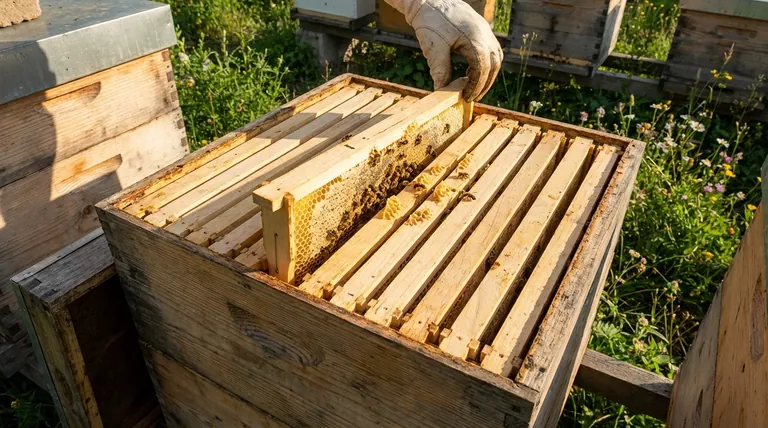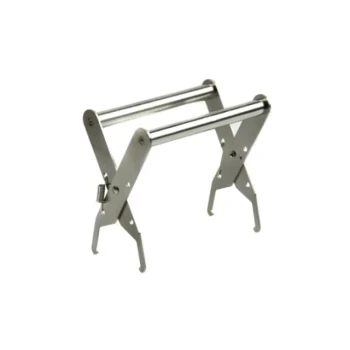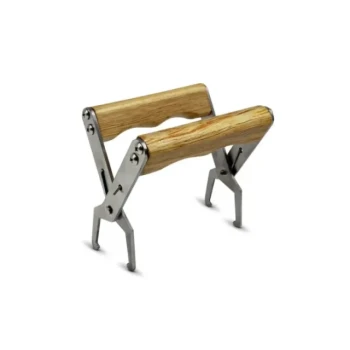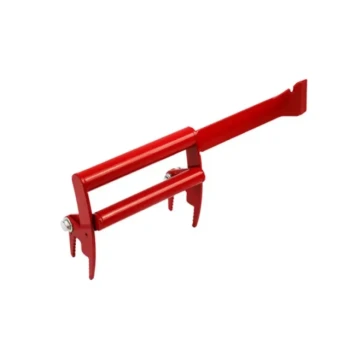By design, a 10-frame hive body holds exactly ten frames. This standard measurement is the foundation of the most common beekeeping equipment used in North America. However, the number of frames you actually use can vary based on your management style and specific goals for the colony.
The question isn't simply about how many frames fit, but why you would choose a system that holds ten frames. This decision hinges on a fundamental trade-off between the hive's total weight and its potential for honey production and population growth.

The Anatomy of a 10-Frame Hive
A "10-frame hive" refers to equipment built to the specifications of a standard Langstroth hive, named after its inventor, Rev. Lorenzo Langstroth. This design revolutionized beekeeping.
The Importance of "Bee Space"
The entire system works because it respects bee space—a gap of roughly 3/8 of an inch (9.5 mm). This is the precise amount of room bees will naturally leave between their combs.
By spacing ten frames correctly within the box, the beekeeper prevents the bees from building rogue burr comb between the frames or attaching the frames to the hive walls, making inspections possible.
The Industry Standard
The 10-frame Langstroth hive is the default for commercial operations and has been the most popular choice for over a century. This is primarily because it offers the largest internal volume per box, maximizing the potential for a large workforce and substantial honey storage.
Why You Might Use Fewer Than 10 Frames
While the box is built for ten frames, experienced beekeepers sometimes adjust this number for practical reasons. This is a management technique, not a different type of equipment.
Easier Hive Inspections
Some beekeepers prefer to run only nine frames in their 10-frame honey supers. Spacing nine frames out evenly across the box encourages the bees to draw out the honeycomb deeper on each frame.
This practice can make uncapping the honey slightly easier, but its main benefit is providing extra room to pry out the first frame during an inspection without rolling or crushing bees.
Managing a Weak Colony
If a new colony or a weaker hive doesn't have enough bees to cover all ten frames, a beekeeper might temporarily remove one or two frames and insert a follower board. This reduces the internal volume the bees have to defend and keep warm, helping the colony manage its resources more effectively.
The Critical Decision: 10-Frame vs. 8-Frame Equipment
The most important consideration behind your question is the choice between 10-frame and 8-frame equipment. Both are standard Langstroth hives, but their box width is different.
The Case for the 10-Frame Hive
The primary advantage of the 10-frame hive is capacity. With 25% more room per box than an 8-frame hive, a 10-frame system can house a larger population and store more honey. This often translates to fewer boxes to manage for the same amount of honey yield.
Because it's the long-standing industry standard, 10-frame equipment is also universally available and often slightly less expensive.
The Case for the 8-Frame Hive
The key advantage of the 8-frame hive is weight. A deep 10-frame hive body full of brood, pollen, and honey can weigh 80-90 pounds (36-41 kg). An equivalent 8-frame box is significantly lighter, typically weighing 60-70 pounds (27-32 kg).
This weight difference makes the 8-frame system a popular choice for hobbyists, beekeepers with physical limitations, or anyone who wants to make lifting and moving equipment easier.
Making the Right Choice for Your Apiary
Choosing your hive size is one of the first and most impactful decisions you will make. It's best to commit to one size, as the boxes and other components are not interchangeable.
- If your primary focus is maximizing honey production: Choose the 10-frame system for its larger volume and status as the commercial standard.
- If your primary focus is ease of lifting and physical management: Choose the 8-frame system to significantly reduce the weight of each hive box.
- If your primary focus is equipment availability and compatibility: 10-frame equipment is more common, but 8-frame is widely available from all major beekeeping suppliers.
Understanding this fundamental choice empowers you to build an apiary that perfectly matches your beekeeping goals and physical abilities.
Summary Table:
| Hive Type | Frames per Box | Approx. Weight (Full Deep) | Key Advantage |
|---|---|---|---|
| 10-Frame | 10 | 80-90 lbs (36-41 kg) | Maximum honey & brood capacity |
| 8-Frame | 8 | 60-70 lbs (27-32 kg) | Easier lifting & management |
Ready to build an apiary that perfectly matches your goals?
At HONESTBEE, we supply durable, precision-built 10-frame and 8-frame Langstroth hive equipment to commercial apiaries and beekeeping equipment distributors. Our wholesale-focused operations ensure you get the reliable, industry-standard gear you need to maximize honey production or simplify hive management.
Contact HONESTBEE today for wholesale pricing and expert advice on choosing the right hive system for your operation.
Visual Guide

Related Products
- HONESTBEE Wired and Assembled Wooden Bee Frames Foundation for a Thriving Hive
- Assembled Wooden Bee Frames with Beeswax Foundation Ready to Use by HONESTBEE
- Assembled Wooden Bee Frames with Plastic Foundation for Durability and Convenience by HONESTBEE
- Heavy-Duty Stainless Steel Clip-On Frame Perch
- Durable Rubberized Comfort Handle Frame Grip
People Also Ask
- How long do bee frames last? A Guide to Lifespan and Replacement for Healthy Hives
- Can I reuse old frames? A practical guide to saving money and reducing waste
- Can old bee frames be reused? Weighing the Risks vs. Rewards for Your Hive
- When should I throw away my bee frame? A Guide to Hive Health & Frame Rotation
- How should you dry bee frames after cleaning? Prevent Warping and Ensure Hive Health



















